Society Cafe: A Strategic Analysis of Planning for Business Growth
VerifiedAdded on 2023/01/09
|18
|4889
|43
Report
AI Summary
This report analyzes the growth strategies for Society Cafe, a small business, focusing on key considerations for evaluating growth opportunities. It examines resources, competencies, and external factors using PESTLE analysis. The report then evaluates growth opportunities using competitive advantage and Ansoff's Matrix, recommending product development. It assesses different funding sources, including retained earnings, debt financing, and equity financing. The report further outlines a business plan for strategic growth, incorporating financial information. Finally, it evaluates exit or succession options available to the owners, concluding with recommendations for sustainable business performance. The report provides a comprehensive overview of strategic planning and financial considerations for small and medium-sized enterprises.
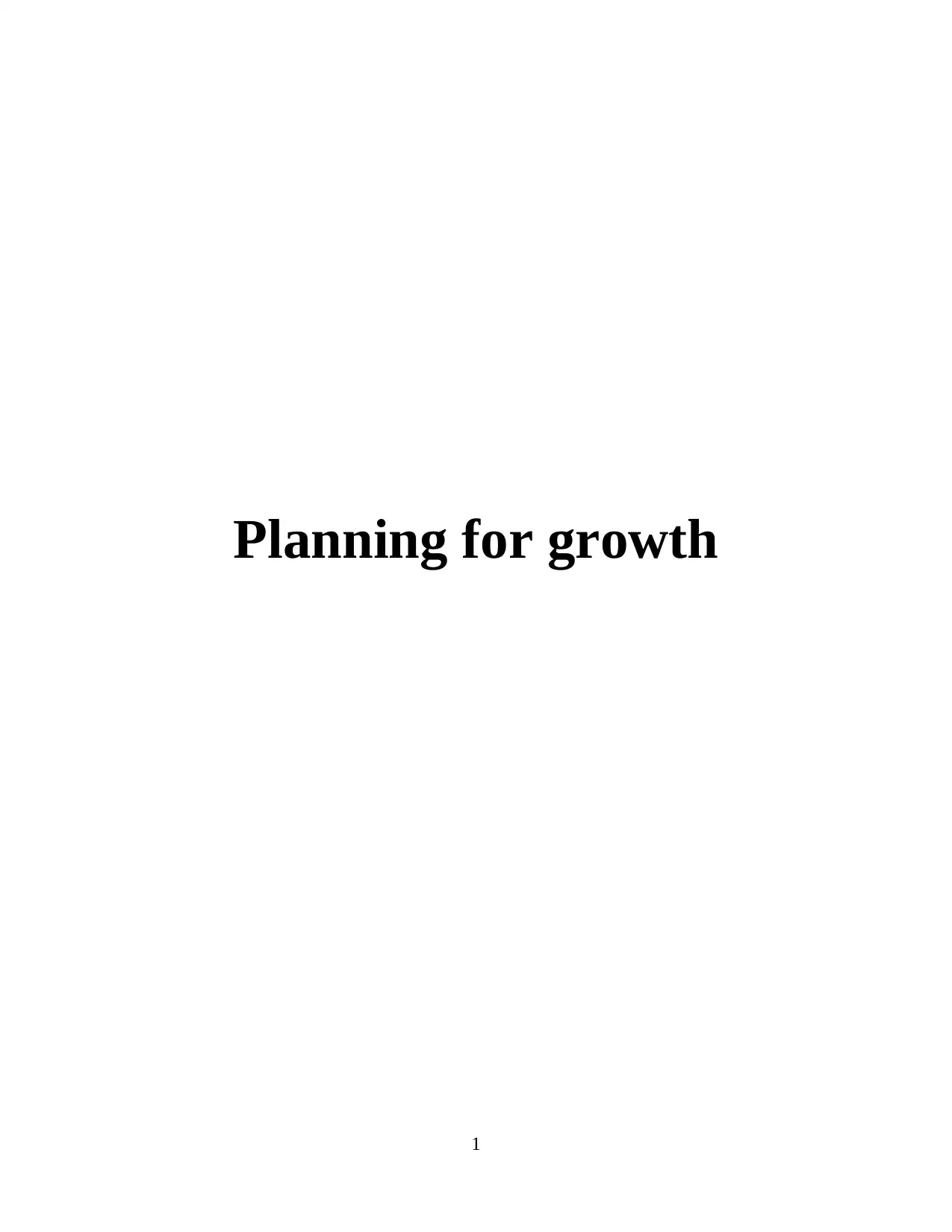
Planning for growth
1
1
Paraphrase This Document
Need a fresh take? Get an instant paraphrase of this document with our AI Paraphraser
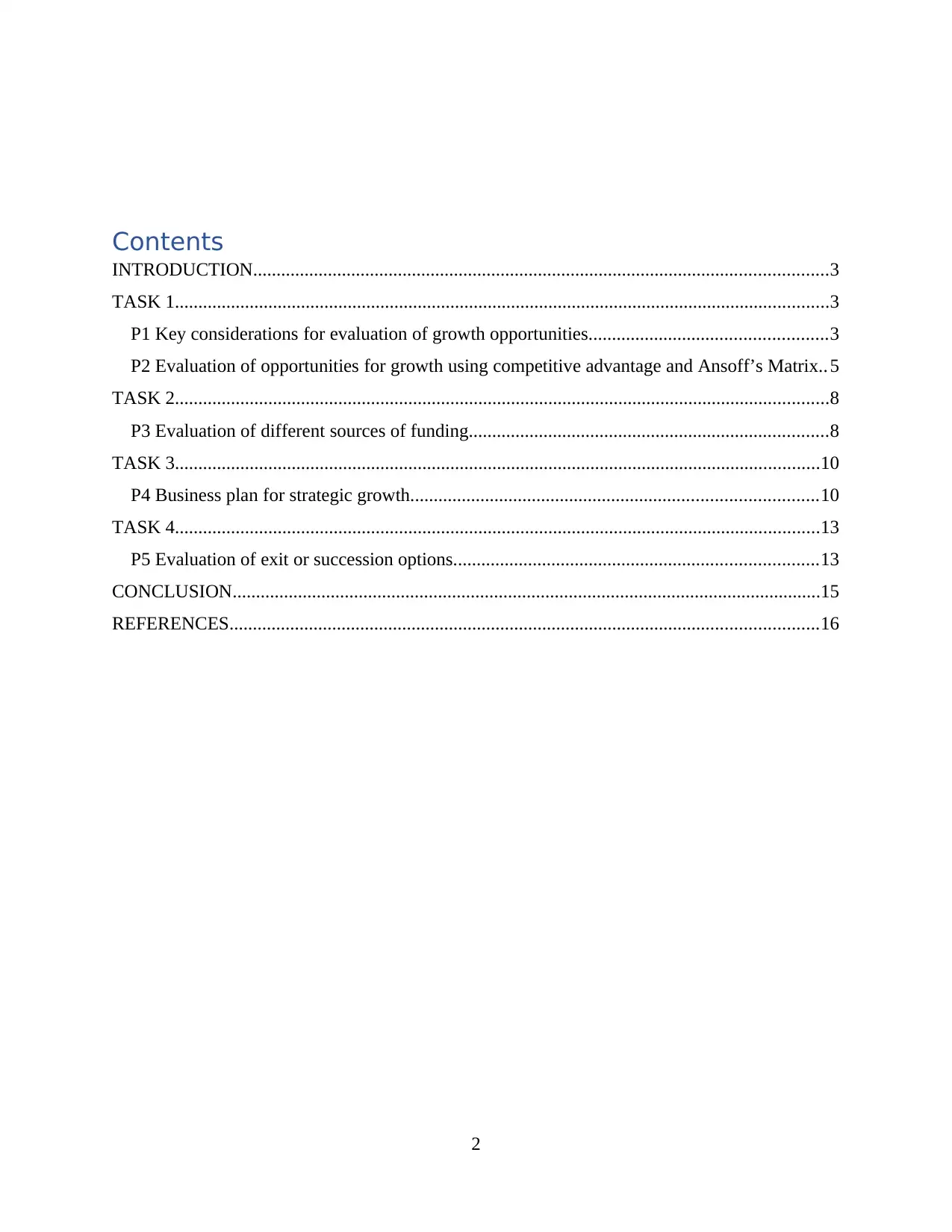
Contents
INTRODUCTION...........................................................................................................................3
TASK 1............................................................................................................................................3
P1 Key considerations for evaluation of growth opportunities...................................................3
P2 Evaluation of opportunities for growth using competitive advantage and Ansoff’s Matrix.. 5
TASK 2............................................................................................................................................8
P3 Evaluation of different sources of funding.............................................................................8
TASK 3..........................................................................................................................................10
P4 Business plan for strategic growth.......................................................................................10
TASK 4..........................................................................................................................................13
P5 Evaluation of exit or succession options..............................................................................13
CONCLUSION..............................................................................................................................15
REFERENCES..............................................................................................................................16
2
INTRODUCTION...........................................................................................................................3
TASK 1............................................................................................................................................3
P1 Key considerations for evaluation of growth opportunities...................................................3
P2 Evaluation of opportunities for growth using competitive advantage and Ansoff’s Matrix.. 5
TASK 2............................................................................................................................................8
P3 Evaluation of different sources of funding.............................................................................8
TASK 3..........................................................................................................................................10
P4 Business plan for strategic growth.......................................................................................10
TASK 4..........................................................................................................................................13
P5 Evaluation of exit or succession options..............................................................................13
CONCLUSION..............................................................................................................................15
REFERENCES..............................................................................................................................16
2
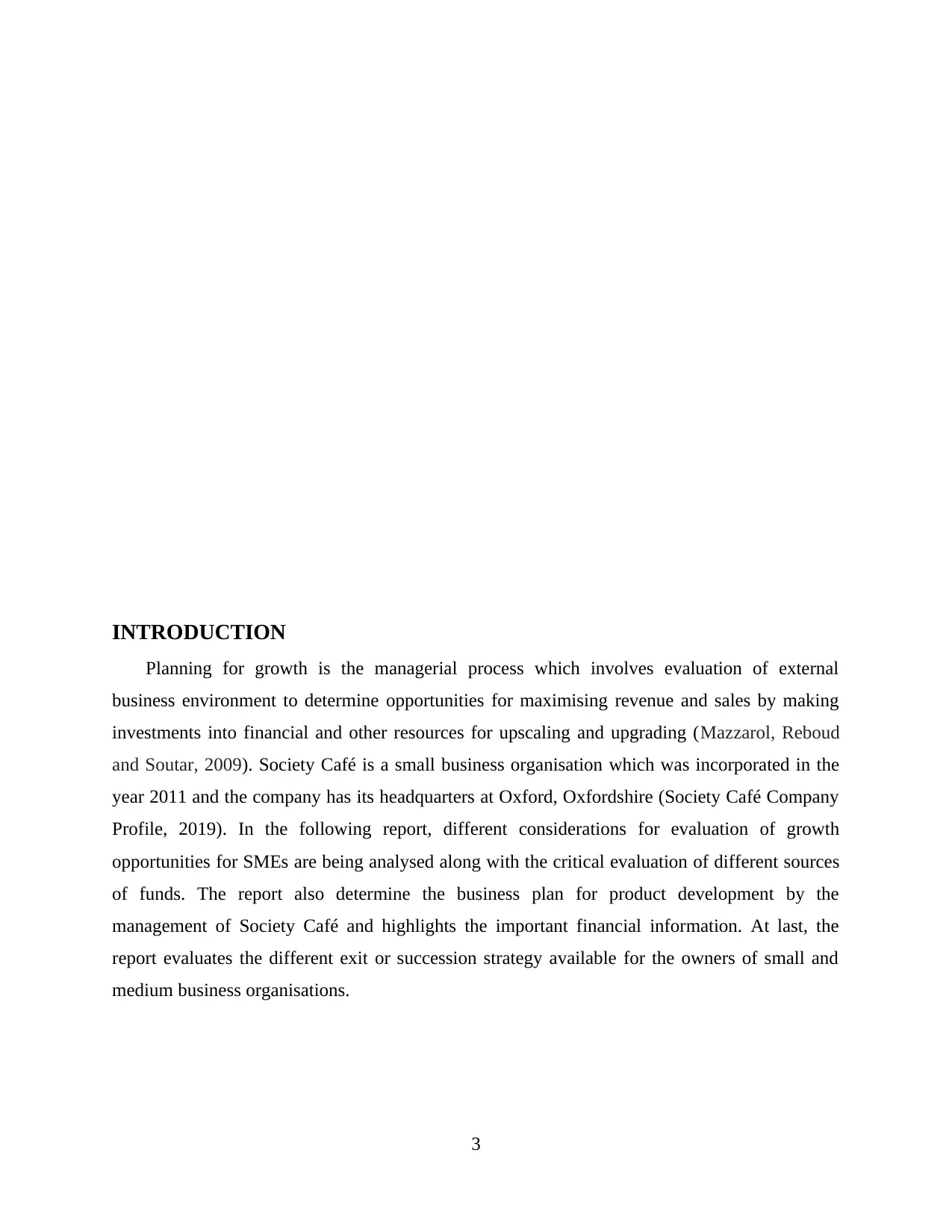
INTRODUCTION
Planning for growth is the managerial process which involves evaluation of external
business environment to determine opportunities for maximising revenue and sales by making
investments into financial and other resources for upscaling and upgrading (Mazzarol, Reboud
and Soutar, 2009). Society Café is a small business organisation which was incorporated in the
year 2011 and the company has its headquarters at Oxford, Oxfordshire (Society Café Company
Profile, 2019). In the following report, different considerations for evaluation of growth
opportunities for SMEs are being analysed along with the critical evaluation of different sources
of funds. The report also determine the business plan for product development by the
management of Society Café and highlights the important financial information. At last, the
report evaluates the different exit or succession strategy available for the owners of small and
medium business organisations.
3
Planning for growth is the managerial process which involves evaluation of external
business environment to determine opportunities for maximising revenue and sales by making
investments into financial and other resources for upscaling and upgrading (Mazzarol, Reboud
and Soutar, 2009). Society Café is a small business organisation which was incorporated in the
year 2011 and the company has its headquarters at Oxford, Oxfordshire (Society Café Company
Profile, 2019). In the following report, different considerations for evaluation of growth
opportunities for SMEs are being analysed along with the critical evaluation of different sources
of funds. The report also determine the business plan for product development by the
management of Society Café and highlights the important financial information. At last, the
report evaluates the different exit or succession strategy available for the owners of small and
medium business organisations.
3
⊘ This is a preview!⊘
Do you want full access?
Subscribe today to unlock all pages.

Trusted by 1+ million students worldwide
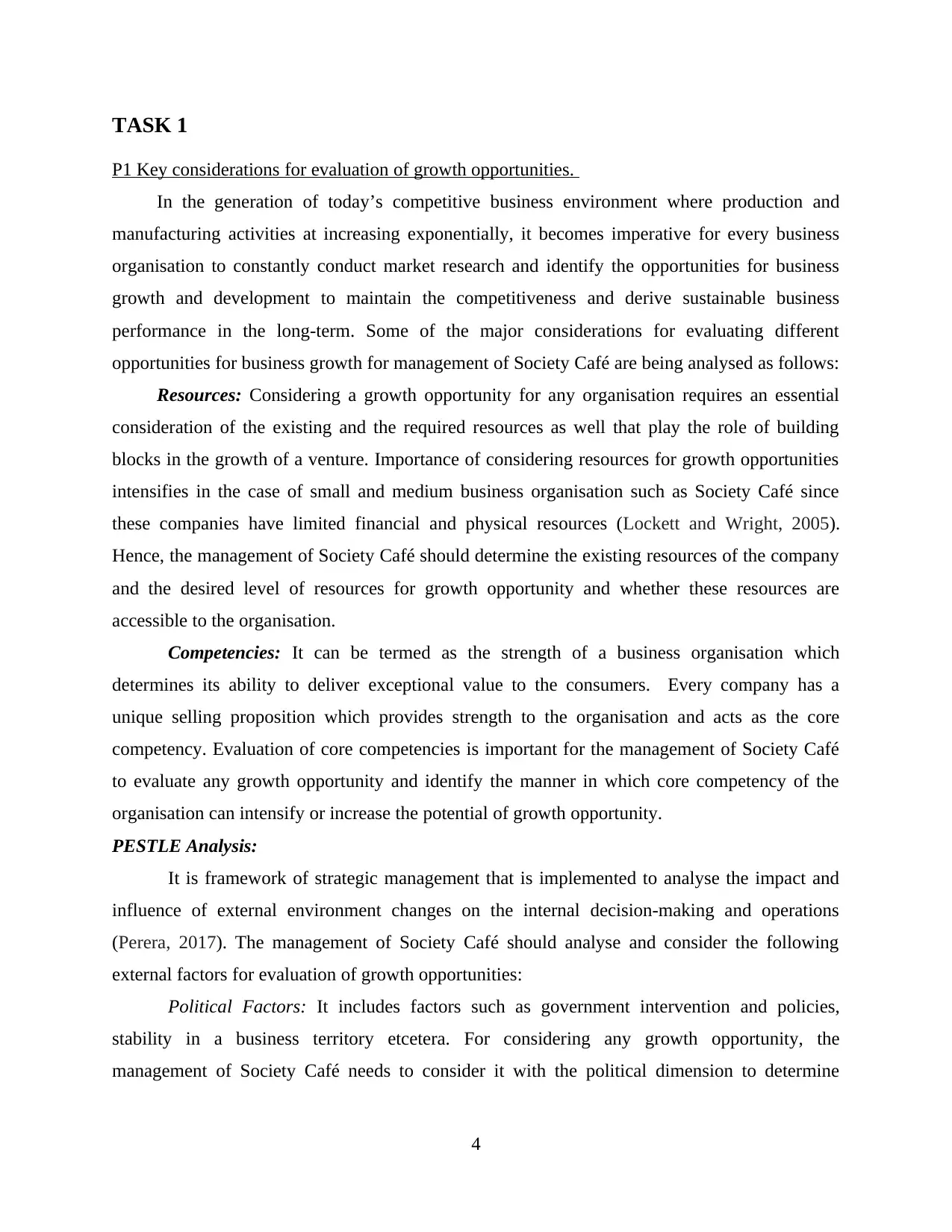
TASK 1
P1 Key considerations for evaluation of growth opportunities.
In the generation of today’s competitive business environment where production and
manufacturing activities at increasing exponentially, it becomes imperative for every business
organisation to constantly conduct market research and identify the opportunities for business
growth and development to maintain the competitiveness and derive sustainable business
performance in the long-term. Some of the major considerations for evaluating different
opportunities for business growth for management of Society Café are being analysed as follows:
Resources: Considering a growth opportunity for any organisation requires an essential
consideration of the existing and the required resources as well that play the role of building
blocks in the growth of a venture. Importance of considering resources for growth opportunities
intensifies in the case of small and medium business organisation such as Society Café since
these companies have limited financial and physical resources (Lockett and Wright, 2005).
Hence, the management of Society Café should determine the existing resources of the company
and the desired level of resources for growth opportunity and whether these resources are
accessible to the organisation.
Competencies: It can be termed as the strength of a business organisation which
determines its ability to deliver exceptional value to the consumers. Every company has a
unique selling proposition which provides strength to the organisation and acts as the core
competency. Evaluation of core competencies is important for the management of Society Café
to evaluate any growth opportunity and identify the manner in which core competency of the
organisation can intensify or increase the potential of growth opportunity.
PESTLE Analysis:
It is framework of strategic management that is implemented to analyse the impact and
influence of external environment changes on the internal decision-making and operations
(Perera, 2017). The management of Society Café should analyse and consider the following
external factors for evaluation of growth opportunities:
Political Factors: It includes factors such as government intervention and policies,
stability in a business territory etcetera. For considering any growth opportunity, the
management of Society Café needs to consider it with the political dimension to determine
4
P1 Key considerations for evaluation of growth opportunities.
In the generation of today’s competitive business environment where production and
manufacturing activities at increasing exponentially, it becomes imperative for every business
organisation to constantly conduct market research and identify the opportunities for business
growth and development to maintain the competitiveness and derive sustainable business
performance in the long-term. Some of the major considerations for evaluating different
opportunities for business growth for management of Society Café are being analysed as follows:
Resources: Considering a growth opportunity for any organisation requires an essential
consideration of the existing and the required resources as well that play the role of building
blocks in the growth of a venture. Importance of considering resources for growth opportunities
intensifies in the case of small and medium business organisation such as Society Café since
these companies have limited financial and physical resources (Lockett and Wright, 2005).
Hence, the management of Society Café should determine the existing resources of the company
and the desired level of resources for growth opportunity and whether these resources are
accessible to the organisation.
Competencies: It can be termed as the strength of a business organisation which
determines its ability to deliver exceptional value to the consumers. Every company has a
unique selling proposition which provides strength to the organisation and acts as the core
competency. Evaluation of core competencies is important for the management of Society Café
to evaluate any growth opportunity and identify the manner in which core competency of the
organisation can intensify or increase the potential of growth opportunity.
PESTLE Analysis:
It is framework of strategic management that is implemented to analyse the impact and
influence of external environment changes on the internal decision-making and operations
(Perera, 2017). The management of Society Café should analyse and consider the following
external factors for evaluation of growth opportunities:
Political Factors: It includes factors such as government intervention and policies,
stability in a business territory etcetera. For considering any growth opportunity, the
management of Society Café needs to consider it with the political dimension to determine
4
Paraphrase This Document
Need a fresh take? Get an instant paraphrase of this document with our AI Paraphraser
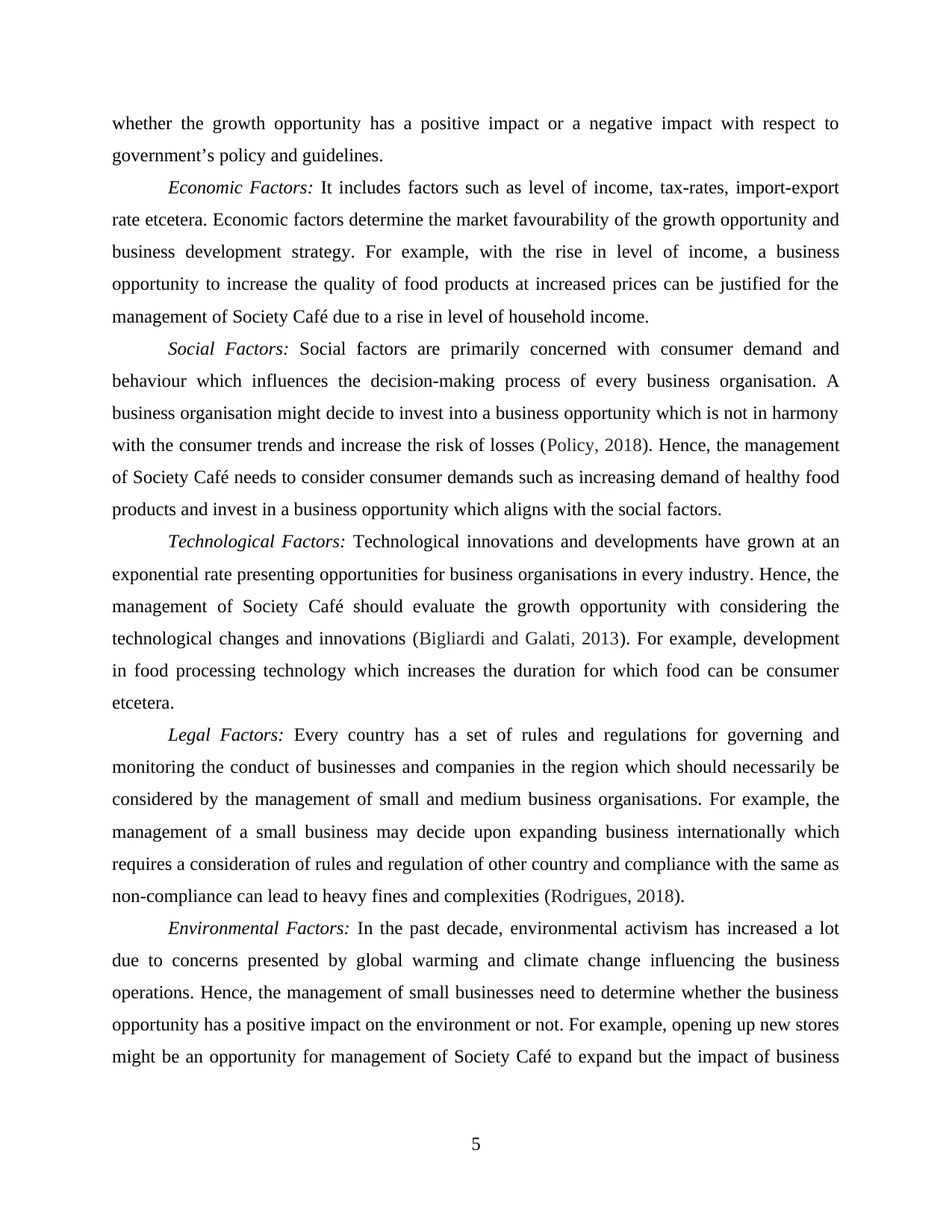
whether the growth opportunity has a positive impact or a negative impact with respect to
government’s policy and guidelines.
Economic Factors: It includes factors such as level of income, tax-rates, import-export
rate etcetera. Economic factors determine the market favourability of the growth opportunity and
business development strategy. For example, with the rise in level of income, a business
opportunity to increase the quality of food products at increased prices can be justified for the
management of Society Café due to a rise in level of household income.
Social Factors: Social factors are primarily concerned with consumer demand and
behaviour which influences the decision-making process of every business organisation. A
business organisation might decide to invest into a business opportunity which is not in harmony
with the consumer trends and increase the risk of losses (Policy, 2018). Hence, the management
of Society Café needs to consider consumer demands such as increasing demand of healthy food
products and invest in a business opportunity which aligns with the social factors.
Technological Factors: Technological innovations and developments have grown at an
exponential rate presenting opportunities for business organisations in every industry. Hence, the
management of Society Café should evaluate the growth opportunity with considering the
technological changes and innovations (Bigliardi and Galati, 2013). For example, development
in food processing technology which increases the duration for which food can be consumer
etcetera.
Legal Factors: Every country has a set of rules and regulations for governing and
monitoring the conduct of businesses and companies in the region which should necessarily be
considered by the management of small and medium business organisations. For example, the
management of a small business may decide upon expanding business internationally which
requires a consideration of rules and regulation of other country and compliance with the same as
non-compliance can lead to heavy fines and complexities (Rodrigues, 2018).
Environmental Factors: In the past decade, environmental activism has increased a lot
due to concerns presented by global warming and climate change influencing the business
operations. Hence, the management of small businesses need to determine whether the business
opportunity has a positive impact on the environment or not. For example, opening up new stores
might be an opportunity for management of Society Café to expand but the impact of business
5
government’s policy and guidelines.
Economic Factors: It includes factors such as level of income, tax-rates, import-export
rate etcetera. Economic factors determine the market favourability of the growth opportunity and
business development strategy. For example, with the rise in level of income, a business
opportunity to increase the quality of food products at increased prices can be justified for the
management of Society Café due to a rise in level of household income.
Social Factors: Social factors are primarily concerned with consumer demand and
behaviour which influences the decision-making process of every business organisation. A
business organisation might decide to invest into a business opportunity which is not in harmony
with the consumer trends and increase the risk of losses (Policy, 2018). Hence, the management
of Society Café needs to consider consumer demands such as increasing demand of healthy food
products and invest in a business opportunity which aligns with the social factors.
Technological Factors: Technological innovations and developments have grown at an
exponential rate presenting opportunities for business organisations in every industry. Hence, the
management of Society Café should evaluate the growth opportunity with considering the
technological changes and innovations (Bigliardi and Galati, 2013). For example, development
in food processing technology which increases the duration for which food can be consumer
etcetera.
Legal Factors: Every country has a set of rules and regulations for governing and
monitoring the conduct of businesses and companies in the region which should necessarily be
considered by the management of small and medium business organisations. For example, the
management of a small business may decide upon expanding business internationally which
requires a consideration of rules and regulation of other country and compliance with the same as
non-compliance can lead to heavy fines and complexities (Rodrigues, 2018).
Environmental Factors: In the past decade, environmental activism has increased a lot
due to concerns presented by global warming and climate change influencing the business
operations. Hence, the management of small businesses need to determine whether the business
opportunity has a positive impact on the environment or not. For example, opening up new stores
might be an opportunity for management of Society Café to expand but the impact of business
5
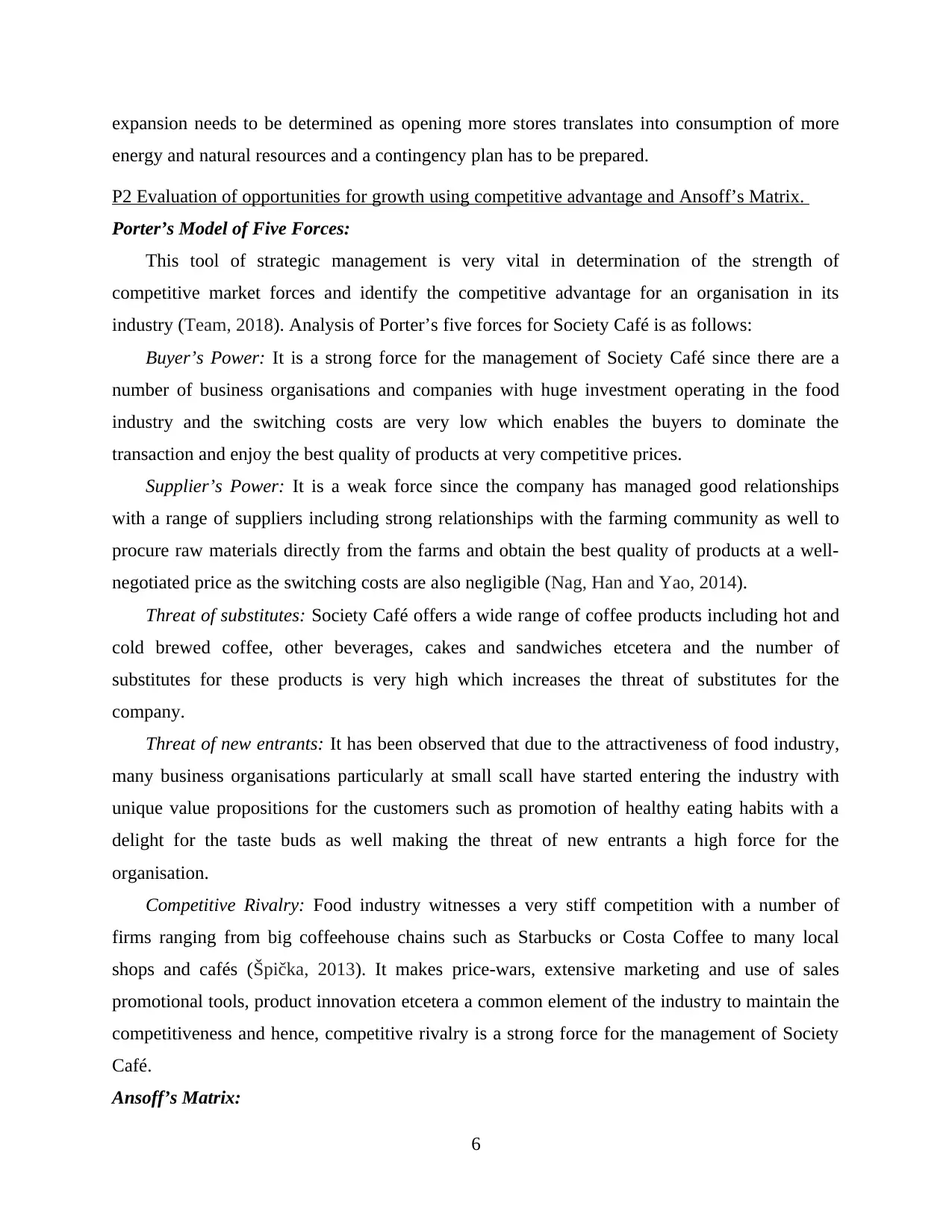
expansion needs to be determined as opening more stores translates into consumption of more
energy and natural resources and a contingency plan has to be prepared.
P2 Evaluation of opportunities for growth using competitive advantage and Ansoff’s Matrix.
Porter’s Model of Five Forces:
This tool of strategic management is very vital in determination of the strength of
competitive market forces and identify the competitive advantage for an organisation in its
industry (Team, 2018). Analysis of Porter’s five forces for Society Café is as follows:
Buyer’s Power: It is a strong force for the management of Society Café since there are a
number of business organisations and companies with huge investment operating in the food
industry and the switching costs are very low which enables the buyers to dominate the
transaction and enjoy the best quality of products at very competitive prices.
Supplier’s Power: It is a weak force since the company has managed good relationships
with a range of suppliers including strong relationships with the farming community as well to
procure raw materials directly from the farms and obtain the best quality of products at a well-
negotiated price as the switching costs are also negligible (Nag, Han and Yao, 2014).
Threat of substitutes: Society Café offers a wide range of coffee products including hot and
cold brewed coffee, other beverages, cakes and sandwiches etcetera and the number of
substitutes for these products is very high which increases the threat of substitutes for the
company.
Threat of new entrants: It has been observed that due to the attractiveness of food industry,
many business organisations particularly at small scall have started entering the industry with
unique value propositions for the customers such as promotion of healthy eating habits with a
delight for the taste buds as well making the threat of new entrants a high force for the
organisation.
Competitive Rivalry: Food industry witnesses a very stiff competition with a number of
firms ranging from big coffeehouse chains such as Starbucks or Costa Coffee to many local
shops and cafés (Špička, 2013). It makes price-wars, extensive marketing and use of sales
promotional tools, product innovation etcetera a common element of the industry to maintain the
competitiveness and hence, competitive rivalry is a strong force for the management of Society
Café.
Ansoff’s Matrix:
6
energy and natural resources and a contingency plan has to be prepared.
P2 Evaluation of opportunities for growth using competitive advantage and Ansoff’s Matrix.
Porter’s Model of Five Forces:
This tool of strategic management is very vital in determination of the strength of
competitive market forces and identify the competitive advantage for an organisation in its
industry (Team, 2018). Analysis of Porter’s five forces for Society Café is as follows:
Buyer’s Power: It is a strong force for the management of Society Café since there are a
number of business organisations and companies with huge investment operating in the food
industry and the switching costs are very low which enables the buyers to dominate the
transaction and enjoy the best quality of products at very competitive prices.
Supplier’s Power: It is a weak force since the company has managed good relationships
with a range of suppliers including strong relationships with the farming community as well to
procure raw materials directly from the farms and obtain the best quality of products at a well-
negotiated price as the switching costs are also negligible (Nag, Han and Yao, 2014).
Threat of substitutes: Society Café offers a wide range of coffee products including hot and
cold brewed coffee, other beverages, cakes and sandwiches etcetera and the number of
substitutes for these products is very high which increases the threat of substitutes for the
company.
Threat of new entrants: It has been observed that due to the attractiveness of food industry,
many business organisations particularly at small scall have started entering the industry with
unique value propositions for the customers such as promotion of healthy eating habits with a
delight for the taste buds as well making the threat of new entrants a high force for the
organisation.
Competitive Rivalry: Food industry witnesses a very stiff competition with a number of
firms ranging from big coffeehouse chains such as Starbucks or Costa Coffee to many local
shops and cafés (Špička, 2013). It makes price-wars, extensive marketing and use of sales
promotional tools, product innovation etcetera a common element of the industry to maintain the
competitiveness and hence, competitive rivalry is a strong force for the management of Society
Café.
Ansoff’s Matrix:
6
⊘ This is a preview!⊘
Do you want full access?
Subscribe today to unlock all pages.

Trusted by 1+ million students worldwide
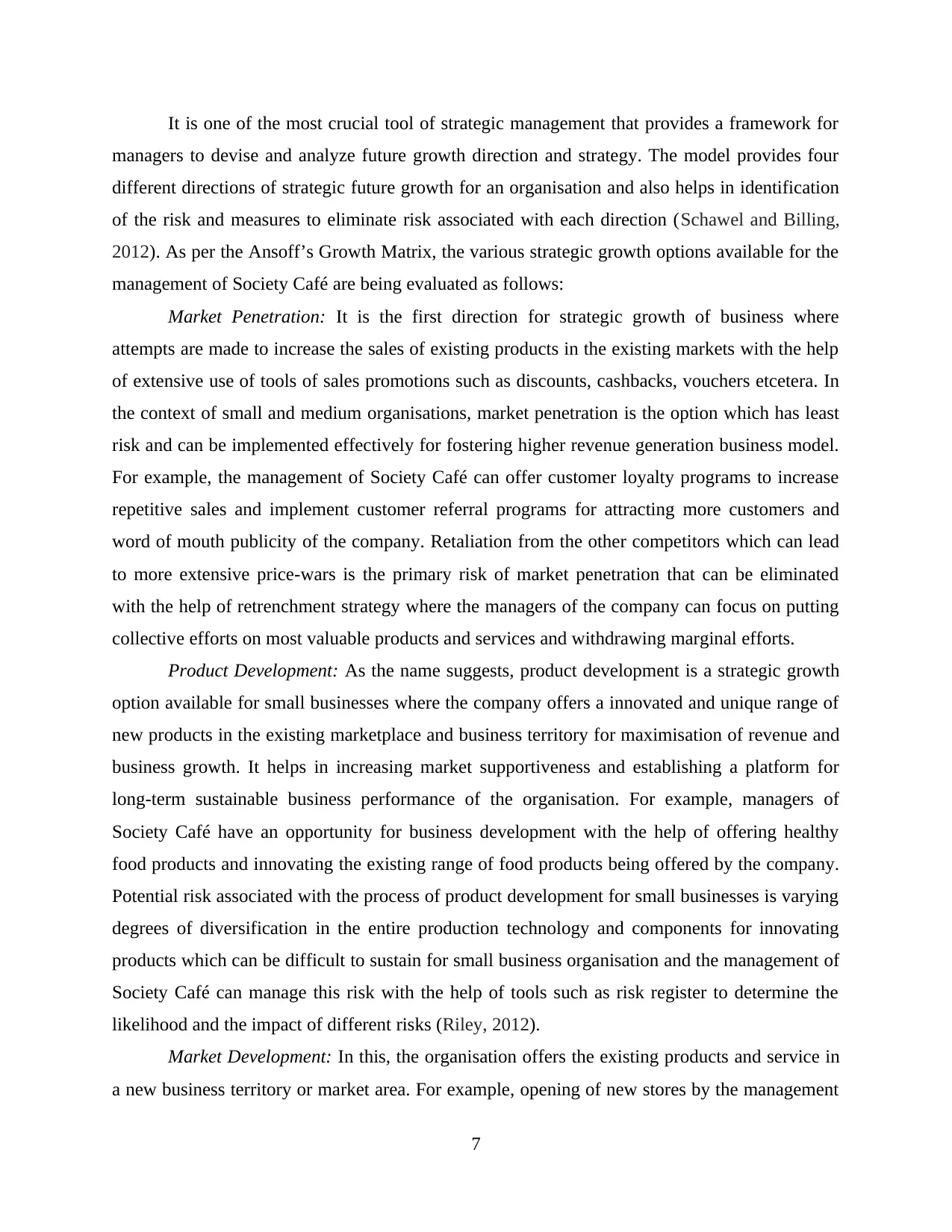
It is one of the most crucial tool of strategic management that provides a framework for
managers to devise and analyze future growth direction and strategy. The model provides four
different directions of strategic future growth for an organisation and also helps in identification
of the risk and measures to eliminate risk associated with each direction (Schawel and Billing,
2012). As per the Ansoff’s Growth Matrix, the various strategic growth options available for the
management of Society Café are being evaluated as follows:
Market Penetration: It is the first direction for strategic growth of business where
attempts are made to increase the sales of existing products in the existing markets with the help
of extensive use of tools of sales promotions such as discounts, cashbacks, vouchers etcetera. In
the context of small and medium organisations, market penetration is the option which has least
risk and can be implemented effectively for fostering higher revenue generation business model.
For example, the management of Society Café can offer customer loyalty programs to increase
repetitive sales and implement customer referral programs for attracting more customers and
word of mouth publicity of the company. Retaliation from the other competitors which can lead
to more extensive price-wars is the primary risk of market penetration that can be eliminated
with the help of retrenchment strategy where the managers of the company can focus on putting
collective efforts on most valuable products and services and withdrawing marginal efforts.
Product Development: As the name suggests, product development is a strategic growth
option available for small businesses where the company offers a innovated and unique range of
new products in the existing marketplace and business territory for maximisation of revenue and
business growth. It helps in increasing market supportiveness and establishing a platform for
long-term sustainable business performance of the organisation. For example, managers of
Society Café have an opportunity for business development with the help of offering healthy
food products and innovating the existing range of food products being offered by the company.
Potential risk associated with the process of product development for small businesses is varying
degrees of diversification in the entire production technology and components for innovating
products which can be difficult to sustain for small business organisation and the management of
Society Café can manage this risk with the help of tools such as risk register to determine the
likelihood and the impact of different risks (Riley, 2012).
Market Development: In this, the organisation offers the existing products and service in
a new business territory or market area. For example, opening of new stores by the management
7
managers to devise and analyze future growth direction and strategy. The model provides four
different directions of strategic future growth for an organisation and also helps in identification
of the risk and measures to eliminate risk associated with each direction (Schawel and Billing,
2012). As per the Ansoff’s Growth Matrix, the various strategic growth options available for the
management of Society Café are being evaluated as follows:
Market Penetration: It is the first direction for strategic growth of business where
attempts are made to increase the sales of existing products in the existing markets with the help
of extensive use of tools of sales promotions such as discounts, cashbacks, vouchers etcetera. In
the context of small and medium organisations, market penetration is the option which has least
risk and can be implemented effectively for fostering higher revenue generation business model.
For example, the management of Society Café can offer customer loyalty programs to increase
repetitive sales and implement customer referral programs for attracting more customers and
word of mouth publicity of the company. Retaliation from the other competitors which can lead
to more extensive price-wars is the primary risk of market penetration that can be eliminated
with the help of retrenchment strategy where the managers of the company can focus on putting
collective efforts on most valuable products and services and withdrawing marginal efforts.
Product Development: As the name suggests, product development is a strategic growth
option available for small businesses where the company offers a innovated and unique range of
new products in the existing marketplace and business territory for maximisation of revenue and
business growth. It helps in increasing market supportiveness and establishing a platform for
long-term sustainable business performance of the organisation. For example, managers of
Society Café have an opportunity for business development with the help of offering healthy
food products and innovating the existing range of food products being offered by the company.
Potential risk associated with the process of product development for small businesses is varying
degrees of diversification in the entire production technology and components for innovating
products which can be difficult to sustain for small business organisation and the management of
Society Café can manage this risk with the help of tools such as risk register to determine the
likelihood and the impact of different risks (Riley, 2012).
Market Development: In this, the organisation offers the existing products and service in
a new business territory or market area. For example, opening of new stores by the management
7
Paraphrase This Document
Need a fresh take? Get an instant paraphrase of this document with our AI Paraphraser
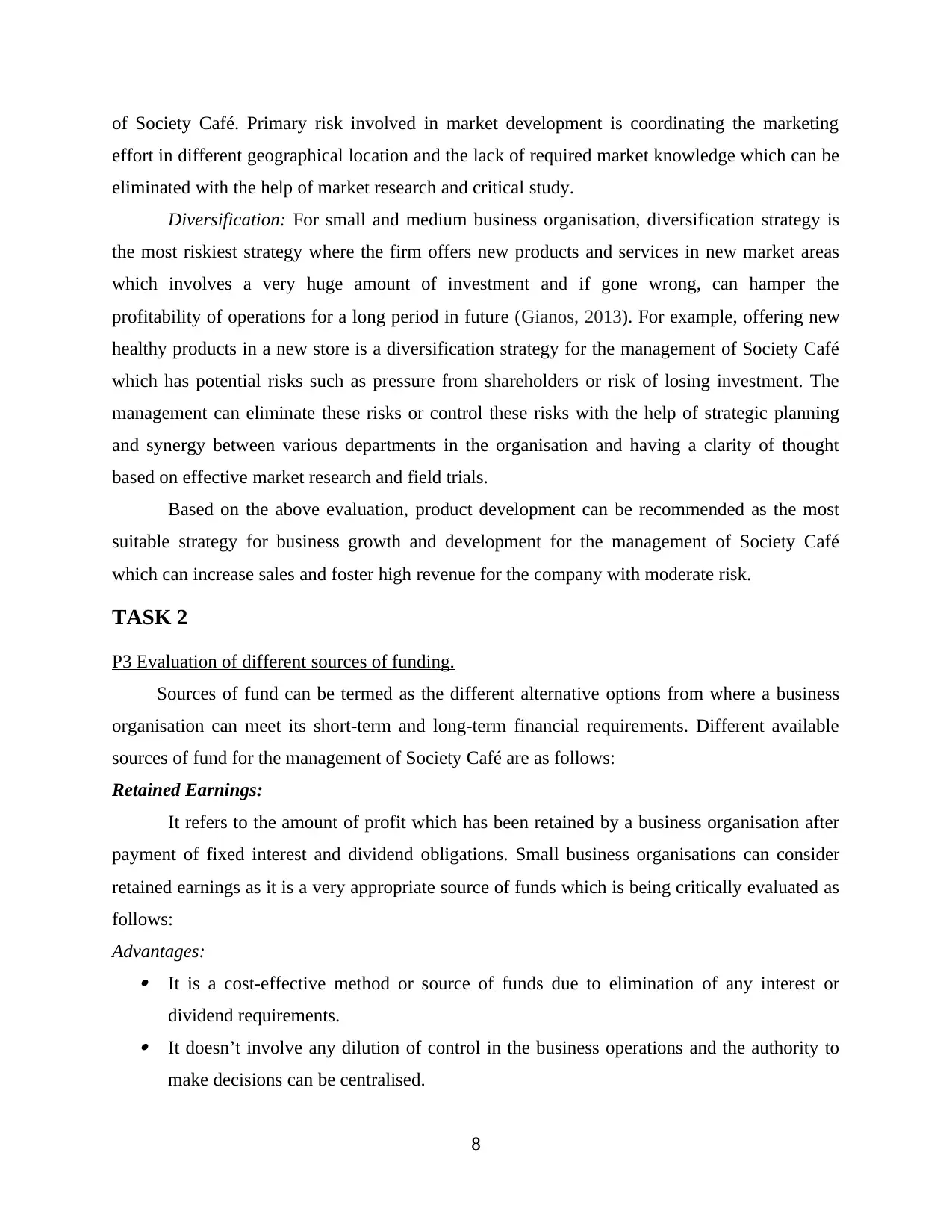
of Society Café. Primary risk involved in market development is coordinating the marketing
effort in different geographical location and the lack of required market knowledge which can be
eliminated with the help of market research and critical study.
Diversification: For small and medium business organisation, diversification strategy is
the most riskiest strategy where the firm offers new products and services in new market areas
which involves a very huge amount of investment and if gone wrong, can hamper the
profitability of operations for a long period in future (Gianos, 2013). For example, offering new
healthy products in a new store is a diversification strategy for the management of Society Café
which has potential risks such as pressure from shareholders or risk of losing investment. The
management can eliminate these risks or control these risks with the help of strategic planning
and synergy between various departments in the organisation and having a clarity of thought
based on effective market research and field trials.
Based on the above evaluation, product development can be recommended as the most
suitable strategy for business growth and development for the management of Society Café
which can increase sales and foster high revenue for the company with moderate risk.
TASK 2
P3 Evaluation of different sources of funding.
Sources of fund can be termed as the different alternative options from where a business
organisation can meet its short-term and long-term financial requirements. Different available
sources of fund for the management of Society Café are as follows:
Retained Earnings:
It refers to the amount of profit which has been retained by a business organisation after
payment of fixed interest and dividend obligations. Small business organisations can consider
retained earnings as it is a very appropriate source of funds which is being critically evaluated as
follows:
Advantages: It is a cost-effective method or source of funds due to elimination of any interest or
dividend requirements. It doesn’t involve any dilution of control in the business operations and the authority to
make decisions can be centralised.
8
effort in different geographical location and the lack of required market knowledge which can be
eliminated with the help of market research and critical study.
Diversification: For small and medium business organisation, diversification strategy is
the most riskiest strategy where the firm offers new products and services in new market areas
which involves a very huge amount of investment and if gone wrong, can hamper the
profitability of operations for a long period in future (Gianos, 2013). For example, offering new
healthy products in a new store is a diversification strategy for the management of Society Café
which has potential risks such as pressure from shareholders or risk of losing investment. The
management can eliminate these risks or control these risks with the help of strategic planning
and synergy between various departments in the organisation and having a clarity of thought
based on effective market research and field trials.
Based on the above evaluation, product development can be recommended as the most
suitable strategy for business growth and development for the management of Society Café
which can increase sales and foster high revenue for the company with moderate risk.
TASK 2
P3 Evaluation of different sources of funding.
Sources of fund can be termed as the different alternative options from where a business
organisation can meet its short-term and long-term financial requirements. Different available
sources of fund for the management of Society Café are as follows:
Retained Earnings:
It refers to the amount of profit which has been retained by a business organisation after
payment of fixed interest and dividend obligations. Small business organisations can consider
retained earnings as it is a very appropriate source of funds which is being critically evaluated as
follows:
Advantages: It is a cost-effective method or source of funds due to elimination of any interest or
dividend requirements. It doesn’t involve any dilution of control in the business operations and the authority to
make decisions can be centralised.
8
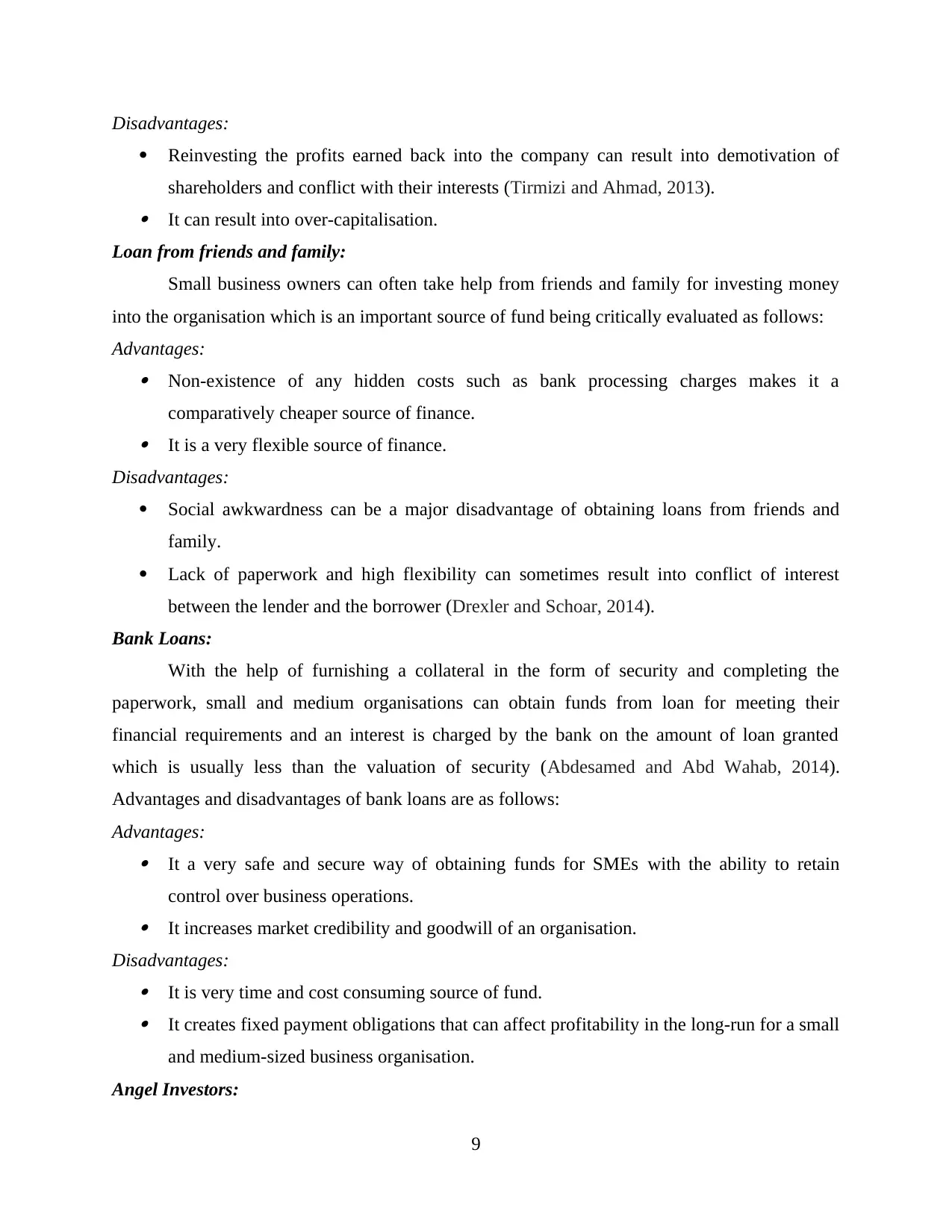
Disadvantages:
Reinvesting the profits earned back into the company can result into demotivation of
shareholders and conflict with their interests (Tirmizi and Ahmad, 2013). It can result into over-capitalisation.
Loan from friends and family:
Small business owners can often take help from friends and family for investing money
into the organisation which is an important source of fund being critically evaluated as follows:
Advantages: Non-existence of any hidden costs such as bank processing charges makes it a
comparatively cheaper source of finance. It is a very flexible source of finance.
Disadvantages:
Social awkwardness can be a major disadvantage of obtaining loans from friends and
family.
Lack of paperwork and high flexibility can sometimes result into conflict of interest
between the lender and the borrower (Drexler and Schoar, 2014).
Bank Loans:
With the help of furnishing a collateral in the form of security and completing the
paperwork, small and medium organisations can obtain funds from loan for meeting their
financial requirements and an interest is charged by the bank on the amount of loan granted
which is usually less than the valuation of security (Abdesamed and Abd Wahab, 2014).
Advantages and disadvantages of bank loans are as follows:
Advantages: It a very safe and secure way of obtaining funds for SMEs with the ability to retain
control over business operations. It increases market credibility and goodwill of an organisation.
Disadvantages: It is very time and cost consuming source of fund. It creates fixed payment obligations that can affect profitability in the long-run for a small
and medium-sized business organisation.
Angel Investors:
9
Reinvesting the profits earned back into the company can result into demotivation of
shareholders and conflict with their interests (Tirmizi and Ahmad, 2013). It can result into over-capitalisation.
Loan from friends and family:
Small business owners can often take help from friends and family for investing money
into the organisation which is an important source of fund being critically evaluated as follows:
Advantages: Non-existence of any hidden costs such as bank processing charges makes it a
comparatively cheaper source of finance. It is a very flexible source of finance.
Disadvantages:
Social awkwardness can be a major disadvantage of obtaining loans from friends and
family.
Lack of paperwork and high flexibility can sometimes result into conflict of interest
between the lender and the borrower (Drexler and Schoar, 2014).
Bank Loans:
With the help of furnishing a collateral in the form of security and completing the
paperwork, small and medium organisations can obtain funds from loan for meeting their
financial requirements and an interest is charged by the bank on the amount of loan granted
which is usually less than the valuation of security (Abdesamed and Abd Wahab, 2014).
Advantages and disadvantages of bank loans are as follows:
Advantages: It a very safe and secure way of obtaining funds for SMEs with the ability to retain
control over business operations. It increases market credibility and goodwill of an organisation.
Disadvantages: It is very time and cost consuming source of fund. It creates fixed payment obligations that can affect profitability in the long-run for a small
and medium-sized business organisation.
Angel Investors:
9
⊘ This is a preview!⊘
Do you want full access?
Subscribe today to unlock all pages.

Trusted by 1+ million students worldwide
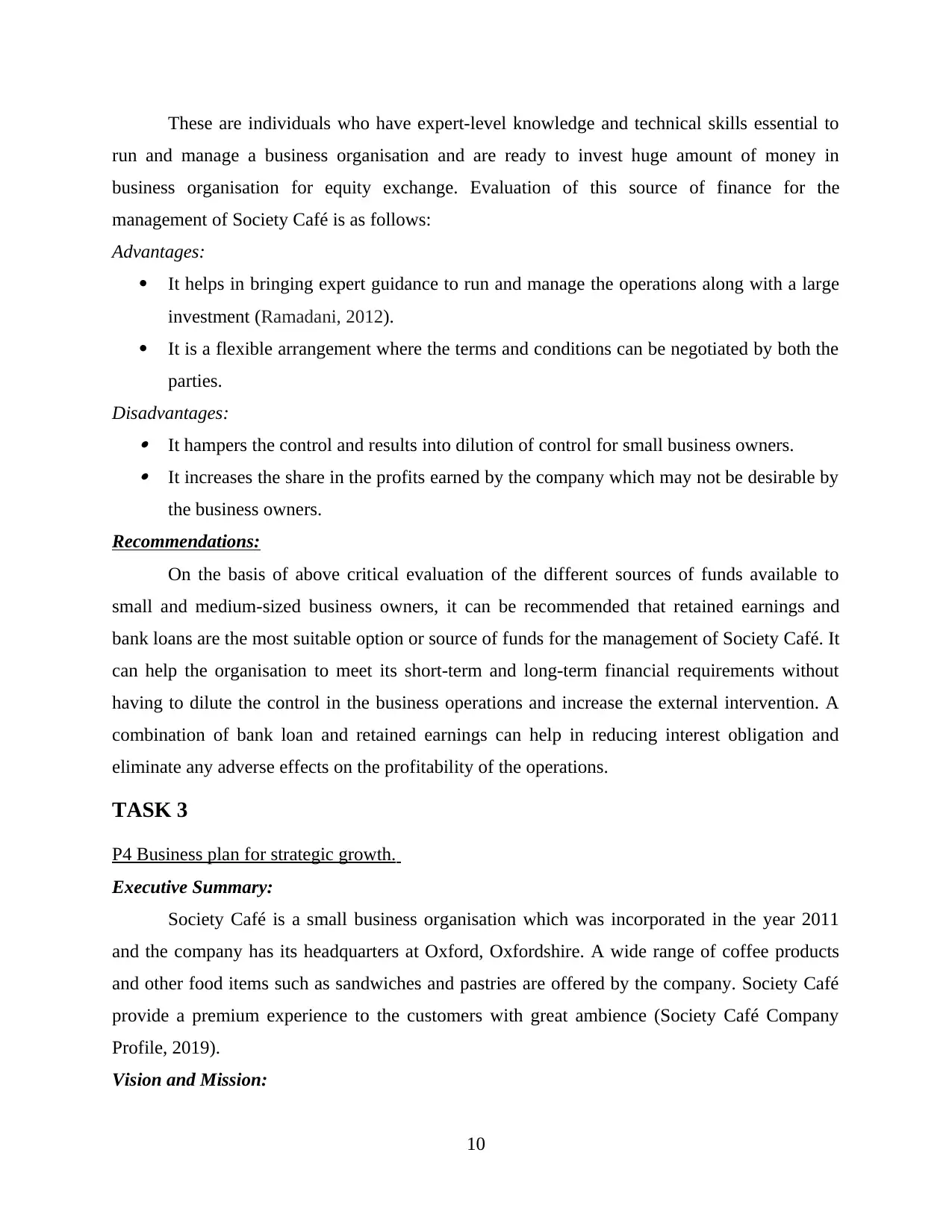
These are individuals who have expert-level knowledge and technical skills essential to
run and manage a business organisation and are ready to invest huge amount of money in
business organisation for equity exchange. Evaluation of this source of finance for the
management of Society Café is as follows:
Advantages:
It helps in bringing expert guidance to run and manage the operations along with a large
investment (Ramadani, 2012).
It is a flexible arrangement where the terms and conditions can be negotiated by both the
parties.
Disadvantages: It hampers the control and results into dilution of control for small business owners. It increases the share in the profits earned by the company which may not be desirable by
the business owners.
Recommendations:
On the basis of above critical evaluation of the different sources of funds available to
small and medium-sized business owners, it can be recommended that retained earnings and
bank loans are the most suitable option or source of funds for the management of Society Café. It
can help the organisation to meet its short-term and long-term financial requirements without
having to dilute the control in the business operations and increase the external intervention. A
combination of bank loan and retained earnings can help in reducing interest obligation and
eliminate any adverse effects on the profitability of the operations.
TASK 3
P4 Business plan for strategic growth.
Executive Summary:
Society Café is a small business organisation which was incorporated in the year 2011
and the company has its headquarters at Oxford, Oxfordshire. A wide range of coffee products
and other food items such as sandwiches and pastries are offered by the company. Society Café
provide a premium experience to the customers with great ambience (Society Café Company
Profile, 2019).
Vision and Mission:
10
run and manage a business organisation and are ready to invest huge amount of money in
business organisation for equity exchange. Evaluation of this source of finance for the
management of Society Café is as follows:
Advantages:
It helps in bringing expert guidance to run and manage the operations along with a large
investment (Ramadani, 2012).
It is a flexible arrangement where the terms and conditions can be negotiated by both the
parties.
Disadvantages: It hampers the control and results into dilution of control for small business owners. It increases the share in the profits earned by the company which may not be desirable by
the business owners.
Recommendations:
On the basis of above critical evaluation of the different sources of funds available to
small and medium-sized business owners, it can be recommended that retained earnings and
bank loans are the most suitable option or source of funds for the management of Society Café. It
can help the organisation to meet its short-term and long-term financial requirements without
having to dilute the control in the business operations and increase the external intervention. A
combination of bank loan and retained earnings can help in reducing interest obligation and
eliminate any adverse effects on the profitability of the operations.
TASK 3
P4 Business plan for strategic growth.
Executive Summary:
Society Café is a small business organisation which was incorporated in the year 2011
and the company has its headquarters at Oxford, Oxfordshire. A wide range of coffee products
and other food items such as sandwiches and pastries are offered by the company. Society Café
provide a premium experience to the customers with great ambience (Society Café Company
Profile, 2019).
Vision and Mission:
10
Paraphrase This Document
Need a fresh take? Get an instant paraphrase of this document with our AI Paraphraser
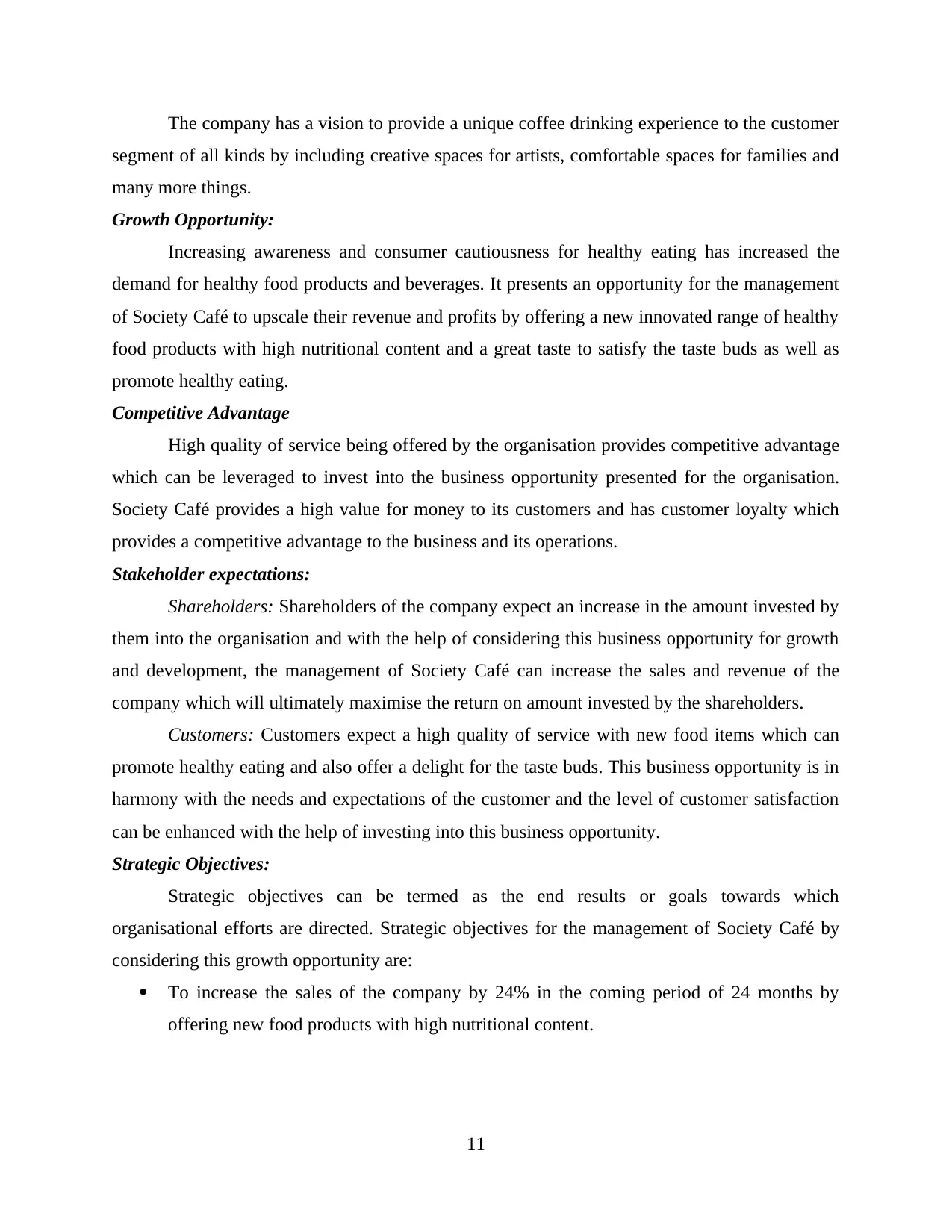
The company has a vision to provide a unique coffee drinking experience to the customer
segment of all kinds by including creative spaces for artists, comfortable spaces for families and
many more things.
Growth Opportunity:
Increasing awareness and consumer cautiousness for healthy eating has increased the
demand for healthy food products and beverages. It presents an opportunity for the management
of Society Café to upscale their revenue and profits by offering a new innovated range of healthy
food products with high nutritional content and a great taste to satisfy the taste buds as well as
promote healthy eating.
Competitive Advantage
High quality of service being offered by the organisation provides competitive advantage
which can be leveraged to invest into the business opportunity presented for the organisation.
Society Café provides a high value for money to its customers and has customer loyalty which
provides a competitive advantage to the business and its operations.
Stakeholder expectations:
Shareholders: Shareholders of the company expect an increase in the amount invested by
them into the organisation and with the help of considering this business opportunity for growth
and development, the management of Society Café can increase the sales and revenue of the
company which will ultimately maximise the return on amount invested by the shareholders.
Customers: Customers expect a high quality of service with new food items which can
promote healthy eating and also offer a delight for the taste buds. This business opportunity is in
harmony with the needs and expectations of the customer and the level of customer satisfaction
can be enhanced with the help of investing into this business opportunity.
Strategic Objectives:
Strategic objectives can be termed as the end results or goals towards which
organisational efforts are directed. Strategic objectives for the management of Society Café by
considering this growth opportunity are:
To increase the sales of the company by 24% in the coming period of 24 months by
offering new food products with high nutritional content.
11
segment of all kinds by including creative spaces for artists, comfortable spaces for families and
many more things.
Growth Opportunity:
Increasing awareness and consumer cautiousness for healthy eating has increased the
demand for healthy food products and beverages. It presents an opportunity for the management
of Society Café to upscale their revenue and profits by offering a new innovated range of healthy
food products with high nutritional content and a great taste to satisfy the taste buds as well as
promote healthy eating.
Competitive Advantage
High quality of service being offered by the organisation provides competitive advantage
which can be leveraged to invest into the business opportunity presented for the organisation.
Society Café provides a high value for money to its customers and has customer loyalty which
provides a competitive advantage to the business and its operations.
Stakeholder expectations:
Shareholders: Shareholders of the company expect an increase in the amount invested by
them into the organisation and with the help of considering this business opportunity for growth
and development, the management of Society Café can increase the sales and revenue of the
company which will ultimately maximise the return on amount invested by the shareholders.
Customers: Customers expect a high quality of service with new food items which can
promote healthy eating and also offer a delight for the taste buds. This business opportunity is in
harmony with the needs and expectations of the customer and the level of customer satisfaction
can be enhanced with the help of investing into this business opportunity.
Strategic Objectives:
Strategic objectives can be termed as the end results or goals towards which
organisational efforts are directed. Strategic objectives for the management of Society Café by
considering this growth opportunity are:
To increase the sales of the company by 24% in the coming period of 24 months by
offering new food products with high nutritional content.
11
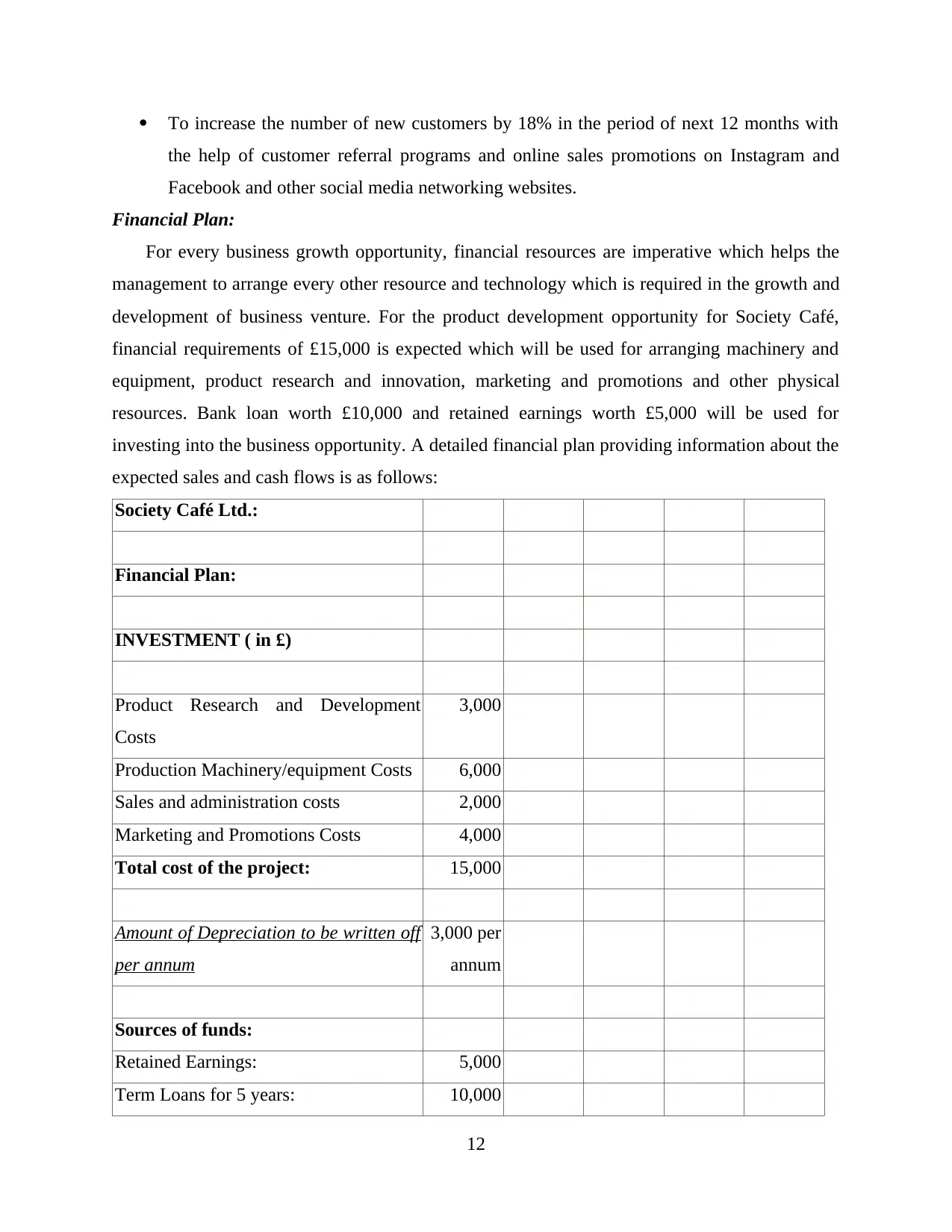
To increase the number of new customers by 18% in the period of next 12 months with
the help of customer referral programs and online sales promotions on Instagram and
Facebook and other social media networking websites.
Financial Plan:
For every business growth opportunity, financial resources are imperative which helps the
management to arrange every other resource and technology which is required in the growth and
development of business venture. For the product development opportunity for Society Café,
financial requirements of £15,000 is expected which will be used for arranging machinery and
equipment, product research and innovation, marketing and promotions and other physical
resources. Bank loan worth £10,000 and retained earnings worth £5,000 will be used for
investing into the business opportunity. A detailed financial plan providing information about the
expected sales and cash flows is as follows:
Society Café Ltd.:
Financial Plan:
INVESTMENT ( in £)
Product Research and Development
Costs
3,000
Production Machinery/equipment Costs 6,000
Sales and administration costs 2,000
Marketing and Promotions Costs 4,000
Total cost of the project: 15,000
Amount of Depreciation to be written off
per annum
3,000 per
annum
Sources of funds:
Retained Earnings: 5,000
Term Loans for 5 years: 10,000
12
the help of customer referral programs and online sales promotions on Instagram and
Facebook and other social media networking websites.
Financial Plan:
For every business growth opportunity, financial resources are imperative which helps the
management to arrange every other resource and technology which is required in the growth and
development of business venture. For the product development opportunity for Society Café,
financial requirements of £15,000 is expected which will be used for arranging machinery and
equipment, product research and innovation, marketing and promotions and other physical
resources. Bank loan worth £10,000 and retained earnings worth £5,000 will be used for
investing into the business opportunity. A detailed financial plan providing information about the
expected sales and cash flows is as follows:
Society Café Ltd.:
Financial Plan:
INVESTMENT ( in £)
Product Research and Development
Costs
3,000
Production Machinery/equipment Costs 6,000
Sales and administration costs 2,000
Marketing and Promotions Costs 4,000
Total cost of the project: 15,000
Amount of Depreciation to be written off
per annum
3,000 per
annum
Sources of funds:
Retained Earnings: 5,000
Term Loans for 5 years: 10,000
12
⊘ This is a preview!⊘
Do you want full access?
Subscribe today to unlock all pages.

Trusted by 1+ million students worldwide
1 out of 18
Related Documents
Your All-in-One AI-Powered Toolkit for Academic Success.
+13062052269
info@desklib.com
Available 24*7 on WhatsApp / Email
![[object Object]](/_next/static/media/star-bottom.7253800d.svg)
Unlock your academic potential
Copyright © 2020–2025 A2Z Services. All Rights Reserved. Developed and managed by ZUCOL.


